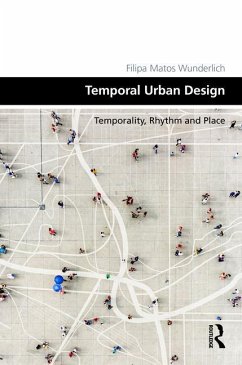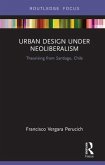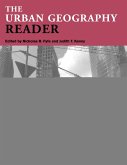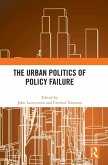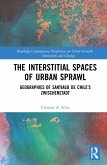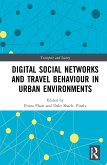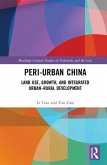- Gebundenes Buch
- Merkliste
- Auf die Merkliste
- Bewerten Bewerten
- Teilen
- Produkt teilen
- Produkterinnerung
- Produkterinnerung
Temporal Urban Design: Temporality, Rhythm and Place examines an alternative design approach, focusing on the temporal aesthetics of urban places and the importance of the sense of time and rhythm in the urban environment.
Andere Kunden interessierten sich auch für
![Urban Design Under Neoliberalism Urban Design Under Neoliberalism]() Francisco Vergara PerucichUrban Design Under Neoliberalism68,99 €
Francisco Vergara PerucichUrban Design Under Neoliberalism68,99 €![The Urban Geography Reader The Urban Geography Reader]() Nick Fyfe / Judith T. Kenny (eds.)The Urban Geography Reader279,99 €
Nick Fyfe / Judith T. Kenny (eds.)The Urban Geography Reader279,99 €![The Urban Politics of Policy Failure The Urban Politics of Policy Failure]() The Urban Politics of Policy Failure180,99 €
The Urban Politics of Policy Failure180,99 €![The Interstitial Spaces of Urban Sprawl The Interstitial Spaces of Urban Sprawl]() Cristian A. SilvaThe Interstitial Spaces of Urban Sprawl194,99 €
Cristian A. SilvaThe Interstitial Spaces of Urban Sprawl194,99 €![Digital Social Networks and Travel Behaviour in Urban Environments Digital Social Networks and Travel Behaviour in Urban Environments]() Digital Social Networks and Travel Behaviour in Urban Environments180,99 €
Digital Social Networks and Travel Behaviour in Urban Environments180,99 €![Urban Theory Beyond the West Urban Theory Beyond the West]() Urban Theory Beyond the West190,99 €
Urban Theory Beyond the West190,99 €![Peri-Urban China Peri-Urban China]() Li TianPeri-Urban China180,99 €
Li TianPeri-Urban China180,99 €-
-
-
Temporal Urban Design: Temporality, Rhythm and Place examines an alternative design approach, focusing on the temporal aesthetics of urban places and the importance of the sense of time and rhythm in the urban environment.
Hinweis: Dieser Artikel kann nur an eine deutsche Lieferadresse ausgeliefert werden.
Hinweis: Dieser Artikel kann nur an eine deutsche Lieferadresse ausgeliefert werden.
Produktdetails
- Produktdetails
- Verlag: Routledge
- Seitenzahl: 252
- Erscheinungstermin: 19. Dezember 2023
- Englisch
- Abmessung: 250mm x 175mm x 18mm
- Gewicht: 620g
- ISBN-13: 9781472468703
- ISBN-10: 1472468708
- Artikelnr.: 60011500
- Herstellerkennzeichnung
- Libri GmbH
- Europaallee 1
- 36244 Bad Hersfeld
- gpsr@libri.de
- Verlag: Routledge
- Seitenzahl: 252
- Erscheinungstermin: 19. Dezember 2023
- Englisch
- Abmessung: 250mm x 175mm x 18mm
- Gewicht: 620g
- ISBN-13: 9781472468703
- ISBN-10: 1472468708
- Artikelnr.: 60011500
- Herstellerkennzeichnung
- Libri GmbH
- Europaallee 1
- 36244 Bad Hersfeld
- gpsr@libri.de
Filipa Matos Wunderlich is an Associate Professor in Urban Design at the Bartlett School of Planning, at University College London (UCL) in the UK. Her research interests are on the temporal dimension of urban place design, sensory urbanism, the interface between urban and musical aesthetics, urban design theory and research by design methodologies. Filipa is the Director of the Master in Research (MRes) in Interdisciplinary Urban Design at the Bartlett School of Planning. She also coordinates 'Research By Design' components for both the Sustainable Urbanism and Urban Design and City Planning MSc Programmes. She is an architect, urban designer and musician.
List of figures
List of tables
Introduction
Chapter 1: The need for a paradigm shift
Why the sense of time and rhythm is important for design
The problem of our cities: new conditions and challenges
The problem with growth-led development
The problem with design: obsolete aesthetics hinder innovation
The intermittent loss of temporality with Covid19
Ways forward: an intellectual and aesthetical review
A doughnut spatial economy: an alternative model
Temporal Urban Design: an alternative aesthetic
Cultural and social place-temporalities as temporal heritage to design for
The need for methodological innovation and interdisciplinarity
The need for a paradigm shift
Chapter 2: Time and temporality in urban design
Incorporating time in urban design studies
Planning cities and time
Governing and delivering through time
Mapping through time: time-geography and urban mobility studies
Managing through time: planning for slowing time in the city
Taking stock of urban design research on time
The significance of senses of time in urban design
Conclusion
Chapter 3: Time and temporality in philosophy and in science
Time or temporality: early conundrums in philosophy and science
The first temporal conundrums: origins of the Western discourses
The dialectics on time: Aristotle and Plato
The early Christian times
The dialectic in the Middle Ages: presentism or eternalism
The progressive and instrumental times of the Middle Ages
Eternalism or Presentism: early to late modern physics
Eternalism: the absolute time
Presentism: the crumbling of time
Quantum time: on spacetime, time and rhythm
The time of the mind, experiential or relational time
Critical debates on the experience of urban time: Bergson and Bachelard
Time as duration: intuition and memory, and its distortion in space, by
Bergson
Time as discontinuous and creative, by Bachelard
Duration, temporality and rhythm
Temporality: as concrete duration and refrain, by Bergson
Temporality: as created by rhythms, by Bachelard
Listening to rhythms to understand temporal existence
Temporality: phenomenological time, rhythm, rhythmanalysis, assemblage,
refrain and territoriality
Temporality: as the phenomenological time
Distaff theories of time and temporality: Deleuze and Lefebvre
Conclusion
Chapter 4: The urban temporal condition: understanding rhythm in urban
space
Time constructs in society and space
Temporality as a sense or as a process? Time, rhythm and urban space
Temporality as a sense: experiential and representational time
Temporality as a process time through the rhythms of everyday life
Rhythm, refrain and territoriality
The coincident accent on rhythm to express time in space
Towards the territorialisation of time: paradigm shifts in urban critical
theory
Place as temporal: sense of time, sense of place or atmosphere?
Chapter 5: Temporal Urban Design: situating the theory
The case for a turn towards Temporal Urban Design
Manifesto (Thoughts on cities/notes to the urban designer)
What defines Temporal Urban Design?
A new temporal aesthetics for urban place design
The aesthetics of place-temporality
Conclusion: Place-temporality and the principal aspects of its aesthetics
and experience in urban space
Chapter 6: An aesthetics akin to music: a new temporal aesthetics for urban
place design
Music in urban environment research
Music, place-temporality and rhythm: experiencing, performing and listening
The experience
Performing: choreography and resonance
Listening
The conceptual tools
Three musical processes: rhythm, performance and tonality (or tonal
organisation)
Rhythm (as in music)
Rhythm in urban space
The temporal aesthetics of places: eurythmia, performativity and tonality
as in a place-score
Conclusion
Chapter 7: Temporal Urban Design: situating research practice
Temporal Urban Design: interdisciplinarity and inherent intellectual
foundations
Place-rhythmanalysis: a methodology for temporal urban place design
Researching the temporality and rhythmicity of urban landscapes
Rhythmanalysis in urban studies
The focus on place-rhythmanalysis
Place-rhythmanalysis: ethnography into the temporal phenomenology of places
Working as a place-rhythmanalyst
Listening to urban place as a musician in urban places
The process: the fieldwork
The process: the analysis
Conclusion
Chapter 8: A place-rhythmanalysis: the singular rhythms and temporality of
Fitzroy Square
At Fitzroy Square
An everyday place
Architecture and public space design
Nature at the square
Everyday social and cultural profile
A residential and communal square
A multicultural place
An events place
A working and institutionally representative square
An exceptional private-public garden square
Location and relationship to the wider neighbourhood
A particular sense of time, or tempo and the aesthetic significance
Spatial expression of place-rhythms at Fitzroy Square
Social place-rhythms: societal, cultural and functional
At Fitzroy Square
Physical place-rhythms
Natural place-rhythms
Temporal expression of place-rhythms: an horizontal place-rhythmanalysis
Principles for temporal horizontal place-rhythmanalysis
An horizontal temporal rhythmanalysis of social place-rhythms at Fitzroy
Square
Physical and natural place-rhythms rhythmanalysis
Temporal expression of place-rhythms: a vertical place-rhythmanalysis
Principles for the temporal vertical analysis
Eurythmia at Fitzroy Square: One day performative narratives
A place-score on the temporal rhythmic aesthetics of place: a
representation and interpretation tool for urban designers
The rhythmic DNA of one day at Fitzroy Square: intensity and accentuation
barcodes
Summary
Chapter 9: Temporal urban design: Situating practice (epilogue)
Introduction
Framing the realm of practice
Temporary, Acupuncture and Tactical Urbanism
Participatory Data Urbanism
Sensorial and Performative Urbanism
Practising Temporal Urban Design: framing action
A collaborative route to methodological innovation
Tactical interventionism
Craft and craftsmanship in the temporal design of the city
Craftsmanship in urban place-rhythmanalysis
Collective urban craftmanship processes in places co-production
Designing for the Slow and Soft City
Conclusion
References
Index
List of tables
Introduction
Chapter 1: The need for a paradigm shift
Why the sense of time and rhythm is important for design
The problem of our cities: new conditions and challenges
The problem with growth-led development
The problem with design: obsolete aesthetics hinder innovation
The intermittent loss of temporality with Covid19
Ways forward: an intellectual and aesthetical review
A doughnut spatial economy: an alternative model
Temporal Urban Design: an alternative aesthetic
Cultural and social place-temporalities as temporal heritage to design for
The need for methodological innovation and interdisciplinarity
The need for a paradigm shift
Chapter 2: Time and temporality in urban design
Incorporating time in urban design studies
Planning cities and time
Governing and delivering through time
Mapping through time: time-geography and urban mobility studies
Managing through time: planning for slowing time in the city
Taking stock of urban design research on time
The significance of senses of time in urban design
Conclusion
Chapter 3: Time and temporality in philosophy and in science
Time or temporality: early conundrums in philosophy and science
The first temporal conundrums: origins of the Western discourses
The dialectics on time: Aristotle and Plato
The early Christian times
The dialectic in the Middle Ages: presentism or eternalism
The progressive and instrumental times of the Middle Ages
Eternalism or Presentism: early to late modern physics
Eternalism: the absolute time
Presentism: the crumbling of time
Quantum time: on spacetime, time and rhythm
The time of the mind, experiential or relational time
Critical debates on the experience of urban time: Bergson and Bachelard
Time as duration: intuition and memory, and its distortion in space, by
Bergson
Time as discontinuous and creative, by Bachelard
Duration, temporality and rhythm
Temporality: as concrete duration and refrain, by Bergson
Temporality: as created by rhythms, by Bachelard
Listening to rhythms to understand temporal existence
Temporality: phenomenological time, rhythm, rhythmanalysis, assemblage,
refrain and territoriality
Temporality: as the phenomenological time
Distaff theories of time and temporality: Deleuze and Lefebvre
Conclusion
Chapter 4: The urban temporal condition: understanding rhythm in urban
space
Time constructs in society and space
Temporality as a sense or as a process? Time, rhythm and urban space
Temporality as a sense: experiential and representational time
Temporality as a process time through the rhythms of everyday life
Rhythm, refrain and territoriality
The coincident accent on rhythm to express time in space
Towards the territorialisation of time: paradigm shifts in urban critical
theory
Place as temporal: sense of time, sense of place or atmosphere?
Chapter 5: Temporal Urban Design: situating the theory
The case for a turn towards Temporal Urban Design
Manifesto (Thoughts on cities/notes to the urban designer)
What defines Temporal Urban Design?
A new temporal aesthetics for urban place design
The aesthetics of place-temporality
Conclusion: Place-temporality and the principal aspects of its aesthetics
and experience in urban space
Chapter 6: An aesthetics akin to music: a new temporal aesthetics for urban
place design
Music in urban environment research
Music, place-temporality and rhythm: experiencing, performing and listening
The experience
Performing: choreography and resonance
Listening
The conceptual tools
Three musical processes: rhythm, performance and tonality (or tonal
organisation)
Rhythm (as in music)
Rhythm in urban space
The temporal aesthetics of places: eurythmia, performativity and tonality
as in a place-score
Conclusion
Chapter 7: Temporal Urban Design: situating research practice
Temporal Urban Design: interdisciplinarity and inherent intellectual
foundations
Place-rhythmanalysis: a methodology for temporal urban place design
Researching the temporality and rhythmicity of urban landscapes
Rhythmanalysis in urban studies
The focus on place-rhythmanalysis
Place-rhythmanalysis: ethnography into the temporal phenomenology of places
Working as a place-rhythmanalyst
Listening to urban place as a musician in urban places
The process: the fieldwork
The process: the analysis
Conclusion
Chapter 8: A place-rhythmanalysis: the singular rhythms and temporality of
Fitzroy Square
At Fitzroy Square
An everyday place
Architecture and public space design
Nature at the square
Everyday social and cultural profile
A residential and communal square
A multicultural place
An events place
A working and institutionally representative square
An exceptional private-public garden square
Location and relationship to the wider neighbourhood
A particular sense of time, or tempo and the aesthetic significance
Spatial expression of place-rhythms at Fitzroy Square
Social place-rhythms: societal, cultural and functional
At Fitzroy Square
Physical place-rhythms
Natural place-rhythms
Temporal expression of place-rhythms: an horizontal place-rhythmanalysis
Principles for temporal horizontal place-rhythmanalysis
An horizontal temporal rhythmanalysis of social place-rhythms at Fitzroy
Square
Physical and natural place-rhythms rhythmanalysis
Temporal expression of place-rhythms: a vertical place-rhythmanalysis
Principles for the temporal vertical analysis
Eurythmia at Fitzroy Square: One day performative narratives
A place-score on the temporal rhythmic aesthetics of place: a
representation and interpretation tool for urban designers
The rhythmic DNA of one day at Fitzroy Square: intensity and accentuation
barcodes
Summary
Chapter 9: Temporal urban design: Situating practice (epilogue)
Introduction
Framing the realm of practice
Temporary, Acupuncture and Tactical Urbanism
Participatory Data Urbanism
Sensorial and Performative Urbanism
Practising Temporal Urban Design: framing action
A collaborative route to methodological innovation
Tactical interventionism
Craft and craftsmanship in the temporal design of the city
Craftsmanship in urban place-rhythmanalysis
Collective urban craftmanship processes in places co-production
Designing for the Slow and Soft City
Conclusion
References
Index
List of figures
List of tables
Introduction
Chapter 1: The need for a paradigm shift
Why the sense of time and rhythm is important for design
The problem of our cities: new conditions and challenges
The problem with growth-led development
The problem with design: obsolete aesthetics hinder innovation
The intermittent loss of temporality with Covid19
Ways forward: an intellectual and aesthetical review
A doughnut spatial economy: an alternative model
Temporal Urban Design: an alternative aesthetic
Cultural and social place-temporalities as temporal heritage to design for
The need for methodological innovation and interdisciplinarity
The need for a paradigm shift
Chapter 2: Time and temporality in urban design
Incorporating time in urban design studies
Planning cities and time
Governing and delivering through time
Mapping through time: time-geography and urban mobility studies
Managing through time: planning for slowing time in the city
Taking stock of urban design research on time
The significance of senses of time in urban design
Conclusion
Chapter 3: Time and temporality in philosophy and in science
Time or temporality: early conundrums in philosophy and science
The first temporal conundrums: origins of the Western discourses
The dialectics on time: Aristotle and Plato
The early Christian times
The dialectic in the Middle Ages: presentism or eternalism
The progressive and instrumental times of the Middle Ages
Eternalism or Presentism: early to late modern physics
Eternalism: the absolute time
Presentism: the crumbling of time
Quantum time: on spacetime, time and rhythm
The time of the mind, experiential or relational time
Critical debates on the experience of urban time: Bergson and Bachelard
Time as duration: intuition and memory, and its distortion in space, by
Bergson
Time as discontinuous and creative, by Bachelard
Duration, temporality and rhythm
Temporality: as concrete duration and refrain, by Bergson
Temporality: as created by rhythms, by Bachelard
Listening to rhythms to understand temporal existence
Temporality: phenomenological time, rhythm, rhythmanalysis, assemblage,
refrain and territoriality
Temporality: as the phenomenological time
Distaff theories of time and temporality: Deleuze and Lefebvre
Conclusion
Chapter 4: The urban temporal condition: understanding rhythm in urban
space
Time constructs in society and space
Temporality as a sense or as a process? Time, rhythm and urban space
Temporality as a sense: experiential and representational time
Temporality as a process time through the rhythms of everyday life
Rhythm, refrain and territoriality
The coincident accent on rhythm to express time in space
Towards the territorialisation of time: paradigm shifts in urban critical
theory
Place as temporal: sense of time, sense of place or atmosphere?
Chapter 5: Temporal Urban Design: situating the theory
The case for a turn towards Temporal Urban Design
Manifesto (Thoughts on cities/notes to the urban designer)
What defines Temporal Urban Design?
A new temporal aesthetics for urban place design
The aesthetics of place-temporality
Conclusion: Place-temporality and the principal aspects of its aesthetics
and experience in urban space
Chapter 6: An aesthetics akin to music: a new temporal aesthetics for urban
place design
Music in urban environment research
Music, place-temporality and rhythm: experiencing, performing and listening
The experience
Performing: choreography and resonance
Listening
The conceptual tools
Three musical processes: rhythm, performance and tonality (or tonal
organisation)
Rhythm (as in music)
Rhythm in urban space
The temporal aesthetics of places: eurythmia, performativity and tonality
as in a place-score
Conclusion
Chapter 7: Temporal Urban Design: situating research practice
Temporal Urban Design: interdisciplinarity and inherent intellectual
foundations
Place-rhythmanalysis: a methodology for temporal urban place design
Researching the temporality and rhythmicity of urban landscapes
Rhythmanalysis in urban studies
The focus on place-rhythmanalysis
Place-rhythmanalysis: ethnography into the temporal phenomenology of places
Working as a place-rhythmanalyst
Listening to urban place as a musician in urban places
The process: the fieldwork
The process: the analysis
Conclusion
Chapter 8: A place-rhythmanalysis: the singular rhythms and temporality of
Fitzroy Square
At Fitzroy Square
An everyday place
Architecture and public space design
Nature at the square
Everyday social and cultural profile
A residential and communal square
A multicultural place
An events place
A working and institutionally representative square
An exceptional private-public garden square
Location and relationship to the wider neighbourhood
A particular sense of time, or tempo and the aesthetic significance
Spatial expression of place-rhythms at Fitzroy Square
Social place-rhythms: societal, cultural and functional
At Fitzroy Square
Physical place-rhythms
Natural place-rhythms
Temporal expression of place-rhythms: an horizontal place-rhythmanalysis
Principles for temporal horizontal place-rhythmanalysis
An horizontal temporal rhythmanalysis of social place-rhythms at Fitzroy
Square
Physical and natural place-rhythms rhythmanalysis
Temporal expression of place-rhythms: a vertical place-rhythmanalysis
Principles for the temporal vertical analysis
Eurythmia at Fitzroy Square: One day performative narratives
A place-score on the temporal rhythmic aesthetics of place: a
representation and interpretation tool for urban designers
The rhythmic DNA of one day at Fitzroy Square: intensity and accentuation
barcodes
Summary
Chapter 9: Temporal urban design: Situating practice (epilogue)
Introduction
Framing the realm of practice
Temporary, Acupuncture and Tactical Urbanism
Participatory Data Urbanism
Sensorial and Performative Urbanism
Practising Temporal Urban Design: framing action
A collaborative route to methodological innovation
Tactical interventionism
Craft and craftsmanship in the temporal design of the city
Craftsmanship in urban place-rhythmanalysis
Collective urban craftmanship processes in places co-production
Designing for the Slow and Soft City
Conclusion
References
Index
List of tables
Introduction
Chapter 1: The need for a paradigm shift
Why the sense of time and rhythm is important for design
The problem of our cities: new conditions and challenges
The problem with growth-led development
The problem with design: obsolete aesthetics hinder innovation
The intermittent loss of temporality with Covid19
Ways forward: an intellectual and aesthetical review
A doughnut spatial economy: an alternative model
Temporal Urban Design: an alternative aesthetic
Cultural and social place-temporalities as temporal heritage to design for
The need for methodological innovation and interdisciplinarity
The need for a paradigm shift
Chapter 2: Time and temporality in urban design
Incorporating time in urban design studies
Planning cities and time
Governing and delivering through time
Mapping through time: time-geography and urban mobility studies
Managing through time: planning for slowing time in the city
Taking stock of urban design research on time
The significance of senses of time in urban design
Conclusion
Chapter 3: Time and temporality in philosophy and in science
Time or temporality: early conundrums in philosophy and science
The first temporal conundrums: origins of the Western discourses
The dialectics on time: Aristotle and Plato
The early Christian times
The dialectic in the Middle Ages: presentism or eternalism
The progressive and instrumental times of the Middle Ages
Eternalism or Presentism: early to late modern physics
Eternalism: the absolute time
Presentism: the crumbling of time
Quantum time: on spacetime, time and rhythm
The time of the mind, experiential or relational time
Critical debates on the experience of urban time: Bergson and Bachelard
Time as duration: intuition and memory, and its distortion in space, by
Bergson
Time as discontinuous and creative, by Bachelard
Duration, temporality and rhythm
Temporality: as concrete duration and refrain, by Bergson
Temporality: as created by rhythms, by Bachelard
Listening to rhythms to understand temporal existence
Temporality: phenomenological time, rhythm, rhythmanalysis, assemblage,
refrain and territoriality
Temporality: as the phenomenological time
Distaff theories of time and temporality: Deleuze and Lefebvre
Conclusion
Chapter 4: The urban temporal condition: understanding rhythm in urban
space
Time constructs in society and space
Temporality as a sense or as a process? Time, rhythm and urban space
Temporality as a sense: experiential and representational time
Temporality as a process time through the rhythms of everyday life
Rhythm, refrain and territoriality
The coincident accent on rhythm to express time in space
Towards the territorialisation of time: paradigm shifts in urban critical
theory
Place as temporal: sense of time, sense of place or atmosphere?
Chapter 5: Temporal Urban Design: situating the theory
The case for a turn towards Temporal Urban Design
Manifesto (Thoughts on cities/notes to the urban designer)
What defines Temporal Urban Design?
A new temporal aesthetics for urban place design
The aesthetics of place-temporality
Conclusion: Place-temporality and the principal aspects of its aesthetics
and experience in urban space
Chapter 6: An aesthetics akin to music: a new temporal aesthetics for urban
place design
Music in urban environment research
Music, place-temporality and rhythm: experiencing, performing and listening
The experience
Performing: choreography and resonance
Listening
The conceptual tools
Three musical processes: rhythm, performance and tonality (or tonal
organisation)
Rhythm (as in music)
Rhythm in urban space
The temporal aesthetics of places: eurythmia, performativity and tonality
as in a place-score
Conclusion
Chapter 7: Temporal Urban Design: situating research practice
Temporal Urban Design: interdisciplinarity and inherent intellectual
foundations
Place-rhythmanalysis: a methodology for temporal urban place design
Researching the temporality and rhythmicity of urban landscapes
Rhythmanalysis in urban studies
The focus on place-rhythmanalysis
Place-rhythmanalysis: ethnography into the temporal phenomenology of places
Working as a place-rhythmanalyst
Listening to urban place as a musician in urban places
The process: the fieldwork
The process: the analysis
Conclusion
Chapter 8: A place-rhythmanalysis: the singular rhythms and temporality of
Fitzroy Square
At Fitzroy Square
An everyday place
Architecture and public space design
Nature at the square
Everyday social and cultural profile
A residential and communal square
A multicultural place
An events place
A working and institutionally representative square
An exceptional private-public garden square
Location and relationship to the wider neighbourhood
A particular sense of time, or tempo and the aesthetic significance
Spatial expression of place-rhythms at Fitzroy Square
Social place-rhythms: societal, cultural and functional
At Fitzroy Square
Physical place-rhythms
Natural place-rhythms
Temporal expression of place-rhythms: an horizontal place-rhythmanalysis
Principles for temporal horizontal place-rhythmanalysis
An horizontal temporal rhythmanalysis of social place-rhythms at Fitzroy
Square
Physical and natural place-rhythms rhythmanalysis
Temporal expression of place-rhythms: a vertical place-rhythmanalysis
Principles for the temporal vertical analysis
Eurythmia at Fitzroy Square: One day performative narratives
A place-score on the temporal rhythmic aesthetics of place: a
representation and interpretation tool for urban designers
The rhythmic DNA of one day at Fitzroy Square: intensity and accentuation
barcodes
Summary
Chapter 9: Temporal urban design: Situating practice (epilogue)
Introduction
Framing the realm of practice
Temporary, Acupuncture and Tactical Urbanism
Participatory Data Urbanism
Sensorial and Performative Urbanism
Practising Temporal Urban Design: framing action
A collaborative route to methodological innovation
Tactical interventionism
Craft and craftsmanship in the temporal design of the city
Craftsmanship in urban place-rhythmanalysis
Collective urban craftmanship processes in places co-production
Designing for the Slow and Soft City
Conclusion
References
Index

